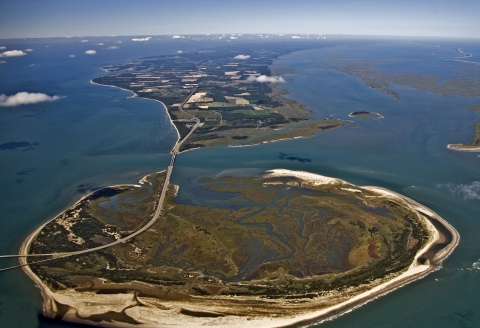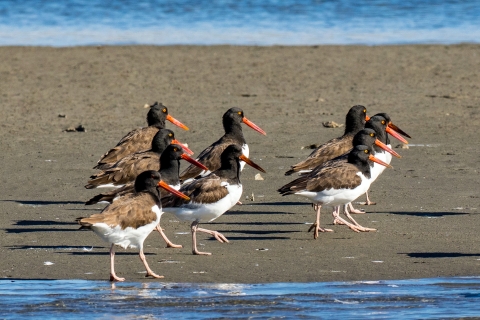About Us
The Virginia barrier island chain, including Fisherman Island National Wildlife Refuge, is one of only 17 sites in the United States classified as a “Wetland of International Importance.” This refuge is located on the southernmost barrier island, at the mouth of the Chesapeake Bay, and is separated from the Eastern Shore of Virginia by about one-half mile of water. Fisherman Island Refuge is designated at an Important Bird Area and is constantly growing. In the late 1800’s it was only 25 acres, while today it spans nearly 2,000 acres!
Because of the critical nature of its habitats for wildlife, Fisherman Island is closed to the public. However, guided tours are offered on Saturdays from October - February (pre-registration required).
Our Mission
Vision
Lying at the tip of the Delmarva Peninsula, the Eastern Shore of Virginia and Fisherman Island National Wildlife Refuges are part of a national system of lands managed to ensure the future of wildlife and its habitats. These refuges serve as one of the country’s most valuable stopovers for migratory birds. Nestled between the Atlantic Ocean and Chesapeake Bay, the refuges include a variety of habitats such as maritime forest, shrub thickets, grasslands, beaches, and tidal wetlands. These habitats provide a vital link for millions of songbirds, raptors, shorebirds, and butterflies to rest and refuel before continuing the rigorous journey to their wintering grounds.
Future conservation efforts lie in the refuges’ commitment to protecting and enhancing the migration corridor through preserving, acquiring, and revegetating hardwood, shrub, and grassland areas. Alliances with nearby landowners will increase available habitat and research will focus on augmenting our knowledge to make biologically sound management decisions. The thousands of people who annually visit this gateway to the Eastern Shore of Virginia will gain an appreciation of the refuges’ unique ecological role. In partnership with the local community, the refuges will also promote the area as a regional tourist destination that contributes to the economic stability of and enhances the quality of life on the Eastern Shore of Virginia. Visitors will leave with an understanding that this place of incredible diversity and ecological importance is part of a larger network of protected lands within the National Wildlife Refuge System, set aside specifically for wildlife.
Refuge Purpose
Each unit of the National Wildlife Refuge System is established to serve a statutory purpose that targets the conservation of native species dependent on its lands and waters. All activities on those acres are reviewed for compatibility with this statutory purpose.
- Transfer of Certain Real Property for Wildlife Conservation Purposes Act (16 U.S.C. 667b–667d): "authorizing land to be transferred without reimbursement to the Secretary of the Interior if the land has particular value for migratory birds."
- Migratory Bird Conservation Act (16 U.S.C. 715–715d, 715e, 715f– 715r): "authorizing the acquisition of land A...for use as an inviolate sanctuary, or for any other management purpose, for migratory birds."
Our History
In 1886, the federal government purchased Fisherman Island for an immigrant quarantine station. The station consisted of barracks for up to 1,000 people and included a kitchen, mess hall, artesian well and keeper's residence.
At the beginning of WWI, in 1914, two 5-inch guns and soldiers from the 4th Company of the Virginia Coastal Artillery National Guard were placed on Fisherman Island. In 1937, a coastal artillery station was reestablished. In early 1942, a battery of 155 mm guns was built to protect minefields across the mouth of the Chesapeake Bay throughout WWII.
The Department of the Navy transferred Fisherman Island to the Department of the Interior in 1973. It was managed as an un-staffed satellite of Back Bay National Wildlife Refuge until 1984, when management was turned over to the newly established Eastern Shore of Virginia National Wildlife Refuge.
Other Facilities in this Complex
We are managed as part of the Chincoteague National Wildlife Refuge Complex. Located on the Eastern Shore of Virginia, this group of sites protect similar habitat types and wildlife. This means common management needs can be applied toward a common purpose throughout the Complex.



